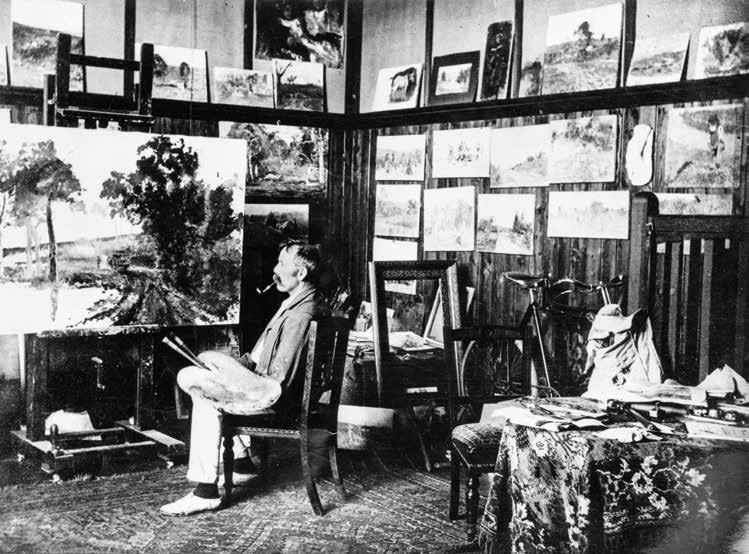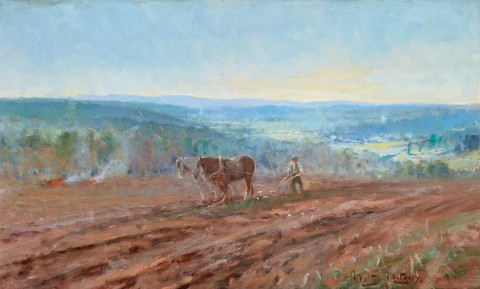EARLY MORNING, ELTHAM, 1909
WALTER WITHERS
oil on canvas
45.5 x 76.5 cm
signed and dated lower right: Walter Withers. / 09
bears inscription with title on label attached to frame verso: Erly [sic.] Morning, Eltham
Private collection, Melbourne
Southern Cross Galleries, Melbourne (as ‘Early Morning, Eltham’)
Private collection, Adelaide, acquired from the above in October 1966
Thence by descent
Private collection, Adelaide
Unknown exhibition, lent by the Ladies Art Association, [Ballarat] (label attached verso)
Exhibition of Past Australian Painters Lent From Private South Australian Collections, Adelaide Festival of Arts, John Martin & Co. Limited, Adelaide, 8 – 29 March 1974, cat. 123 (label attached verso, as ‘Near Eltham')
DH2021 Verco ART Cat (December) - Cat 06 FA.jpg

In the face of parental opposition to his desired career as an artist, Walter Withers came to Australia from England in 1883 and worked as a jackaroo. Life on the land didn’t last long however, and by the following year he had settled in Melbourne and enrolled at the National Gallery school, extending art studies begun earlier at London’s Royal Academy and South Kensington Schools. There, he met fellow students Louis Abrahams and Frederick McCubbin, as well as the older Tom Roberts – all of whom became lifelong friends – earning the nickname ‘The Orderly Colonel’ as a result of his efficient manner and efforts to organise his colleagues.1
Marrying in England in 1887, Withers and his wife, Fanny, subsequently spent six months in Paris. There, he studied at the Académie Julian alongside many international students including the Australians E. Phillips Fox, Tudor St George Tucker and John Longstaff, who had all flocked to the City of Light, at that time, the centre of the art world. His painting, Life Class, Académie Julian, 1887 – 88 (private collection) describes the life drawing sessions that took place there twice-daily, with models posing at each end of a sky-lit studio, and a large coke stove in the foreground to keep them warm.2 With a commission to produce pen and ink illustrations for a book on early Melbourne, Withers returned to Australia the following year, soon moving to Heidelberg outside Melbourne, where he rented Charterisville, ‘a fine old stone mansion with a large barn and stables … a wild romantic garden … a broken fountain, and an odd pedestal here and there [which] suggested the glory of other days.’3 Cottages in the grounds were sub-let to other artists including Tom Humphrey and Leon (Sonny) Pole, and when, in 1894, the lease was taken over by Phillips Fox and Tucker, who ran a school there offering instruction in plein air painting, it became a popular gathering place for local artists.
Renowned as an artist ‘who went out [in]to nature and made sincere and successful attempts to represent her varying moods’4, Withers’ art was widely recognised during these years. In 1894 the National Gallery of Victoria purchased A Bright Winter’s Morning, 1894 for its permanent collection and Tranquil Winter, 1895, was acquired the following year.5 The Storm, 1896 (Art Gallery of New South Wales) was awarded the inaugural Wynne Prize for landscape painting in 1897 – for which he received a generous payment of £40 – and in 1900 Withers won the prestigious prize again. A measure of international acknowledgement came too, with the inclusion of Tranquil Winter in the colonial art exhibition in London in 1898.
Early Morning, Eltham was painted in 1899 and shows Withers at his characteristic best. Gentle morning light illuminates the expansive scene, broad rolling hills in the distance painted in varying shades of pale blue and green. In the foreground, a lone farmer guides a plough which is being pulled by a pair of horses through a furrowed field, and fine plumes of white smoke rise from a small fire burning to the left, the orange embers and flames the only high-key colour in the composition. Smoke from other fires is visible throughout the scene, a symbol of the quiet labour and routines which brought this otherwise seemingly still landscape to life.
Withers found landscape subjects in many parts of Victoria, travelling by pony and jinker, as well as making use of the expanding rail network to venture further afield. Many of his subjects however, were areas close to his home – especially around Heidelberg and later, Eltham – locations he could walk or cycle to, which he reportedly often did with a prepared canvas and lightweight, portable easel slung over his shoulder.6 Heidelberg was like a small, rural village when Withers lived there during the 1890s, providing many picturesque views which he recorded in oil paint and watercolour. This changed as the city and suburbs grew and in 1903, with funds earned from a major commission to paint a series of narrative panels for Purrumbete (the majestic home of pastoralist W. T. Manifold at Camperdown in the Western District of Victoria), Withers and his family moved to Eltham. Located about twenty kilometres north-east of Melbourne, Eltham offered a country environment and experience, with access to the city via a recently established railway service.
As Fanny Withers wrote, ‘Purchasing a cottage there, with an orchard attached, he built for himself a charming Studio, the windows of which open on to a bit of Virgin Bush, where stand stately white gums of great beauty’.7 Having worked in and around Eltham previously, it was an area Withers knew well, and the decision to live there permanently proved to be productive for his art, offering limitless sources of inspiration: ‘Every form of subject was there before him, with the added charm of rural figures at work in the paddocks, as tending their animals near the homesteads, as following the cows towards the milking sheds; in riding their horses to the creek for water. All these incidents were noted by the painter’.8
1. For Withers’ full biography, see Clark, J., and Whitelaw, B., Golden Summers: Heidelberg and Beyond, National Gallery of Victoria, Melbourne, 1985, pp. 28-29 and Andrew Mackenzie, ‘Withers, Walter Herbert (1854-1914)’, Australian Dictionary of Biography, National Centre of Biography, Australian National University, https://adb.anu.edu/biography/withers-walter-herbert-9156/text16183, published first in hardcopy 1990
2. See Taylor, E., ‘The city of light: Australians in Paris’ in Taylor, E., Australian Impressionists in France, National Gallery of Victoria, Melbourne, 2013, pp.10 and 13
3. Whitelaw, B., ‘Melbourne’s Answer in the 90s – ‘Charterisville’’ in Clark & Whitelaw, op. cit., p.172
4. ‘Art of Walter Withers’, The Argus, Melbourne, 29 July 1919, p.6
5. A Bright Winter’s Morning, 1894 was purchased in 1894 and then exchanged with the artist for Tranquil Winter, 1895 the following year. A Bright Winter’s Morning was reacquired for the NGV collection in 1956 when it was bequeathed by Mrs Nina Sheppard.
6. Mackenzie, A., Walter Withers: The Forgotten Manuscripts, Mannagum Press, Lilydale, 1987, pp.24 and 30
7. Ibid, p.27
8. Ibid. p.130
KIRSTY GRANT
